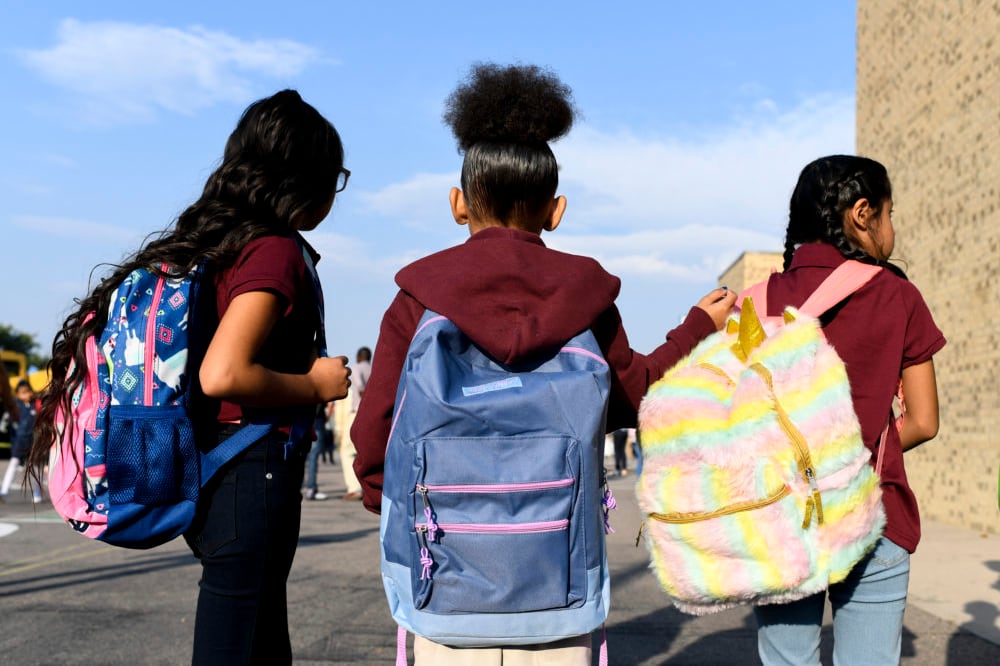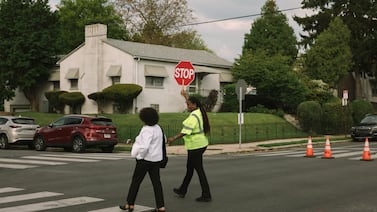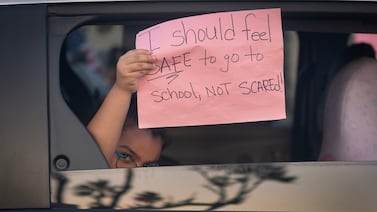Lending an ear, being patient with kids’ emotions, and ensuring kids don’t feel they’re at fault: Offering support like that will help children cope with school closures, according to Jeffco parents who have already been through them.
“I was trying to let him know, ‘we know you don’t like change but this new school is going to become home,’” Jamie Camp said she told her third grader as his school, Fitzmorris Elementary, faced closure in spring 2021 and he would have to move to a new school. “Be patient. They’re going to lash out. Our son did. That’s just them trying to process.”
The Jeffco school district is preparing to help thousands of students say goodbye to their elementary schools at the end of this school year. The board in November is expected to approve a recommendation to close 16 schools, nearly one in five of its elementaries.
In the past two years, the district suddenly closed two small elementary schools that leaders said were no longer sustainable. Now, in a more comprehensive plan, district leaders want to provide more advance notice as they reduce the number of small schools.
Chalkbeat talked to parents of children who attended the two previously closed schools about what worked, what didn’t work, and what advice they had for families facing closures now. Below read their thoughts, and answers to questions on parents’ minds.
Why does the district close schools?
Jeffco, like many other districts, has had fewer and fewer students for many years. That has left many schools with very few students. School districts, and in turn schools, get state funding based on enrollment. Most of the schools recommended for closure have either fewer than 220 students or use less than 45% of their building’s space. The district says it provides these schools more money than their per-student allocation, but they still can’t offer the same programs that bigger schools with more students can afford.
Where will students go?
For every school that is closing, the district has designated another to cover its attendance boundary area and become the new neighborhood school. But Colorado law allows parents to choose other schools, too. Jeffco opens choice enrollment in December for parents wanting to enroll outside their neighborhood.
Rosa Melaragno’s son attended Allendale Elementary until it closed in 2021. Instead of sending him to the district’s suggested school, she chose to send him to Fitzmorris Elementary because it was closer to her home. In the spring, the district closed that school too. Now she believes going with the district’s recommendation would be a safer idea.
“Even if you think it’s going to suck, it might be better for the child in the long run,” Melaragno said.
Other parents who did send their children to the district’s suggested school said they did so because they saw other benefits. Some of their teachers moved to the same school. Others wanted their children to have more familiar classmates or benefit from district support measures for the transferred students.
Lara Wiant, the principal of Campbell Elementary, said that when she took in students from Allendale, she created and assigned student ambassadors to every displaced student to help them navigate the school and to have someone to sit with at lunch.
Christopher Benisch, the principal of Lawrence Elementary School, which received many of the Fitzmorris students, said he designed this year’s classrooms so that every former Fitzmorris student had at least one former classmate in their room this year.
Benisch suggested that as parents look at their choices, they think about what opportunities they want for their children, and they take time to learn about what different programs schools offer. That means asking things like do schools have after-school programs, STEM labs, full-day preschool, or mental health supports?
Any advice on how to say goodbye and then prepare for a new school?
When Fitzmorris was closing, the school hosted a barbecue and invited staff from Lawrence, the school that would be receiving most of Fitzmorris’ students.
Parents say that was helpful for saying goodbye to their community. But looking back, some wish they could have had an opportunity to also meet families of the school they were going to.
And Michelle Miley, whose son was at Fitzmorris but went to Stott Elementary, following his center program for students with autism, wishes that events like that had included families like hers.
This year, as in the past, the district will move students in many of the center programs at closing schools to different receiving schools from the general education students. The district says that’s in part because of space issues. The district is trying to offer stability for those students by moving program staff with the students.
But for children like Miley’s son, who spent about three-quarters of his school day in general education classrooms, getting split away from those students made the family feel left out.
As her son started school this fall, she felt like neither he nor the family knew anyone.
“I feel like I was just kind of thrown in,” Miley said. “Now I hope they try to get the school communities together before schools close. Just to get people more familiar with each other.”
One thing many parents say they’ve found helpful for their children is visiting school playgrounds.
Maureen Bricker cares for her two granddaughters, a fourth and a first grader, who both were displaced from Fitzmorris Elementary. After the school closed, Bricker arranged for the girls to play with other former classmates at their old playground a couple of times.
“I thought let’s let them play like old times, and we’ll do that again as long as it’s open,” Bricker said.
Melaragno said she tried to arrange a play date over the summer for her son, who takes a long time to warm up to people, but got no responses. She thinks it might have helped if the district helped facilitate that.
So she packed a lunch and took her son to his new school over the summer and let him play on the new playground.
“It was just to let him get physically familiar with the school, let him scope it out,” Melaragno said. “Even getting used to the drive and looking at the landmarks. It’s just about taking the time with him.”
What was difficult in the transition and how can parents manage challenges?
Parents said they struggled to adjust to drastically different start times, and much busier drop-off and pickup locations. Parents hope that with more time to plan, school leaders can reduce the stress around those changes.
Parents said one of the most helpful things was clear communication with their kids and letting them know that it’s not their fault they have to change schools.
Melaragno said her husband noticed that their son had felt like he was to blame for having two of his schools shut down.
“Take the lead in explaining to the kids it’s not their fault,” both the Melaragnos said. “Especially those who may not be forthright about their feelings. My son is like that. If he’s sad about something, sometimes he’ll cry but then he’s like ‘I’m fine,’ even though he’s not.”
Camp said her son felt like his parents didn’t try to save his school. She said she hasn’t figured out how parents might let their kids feel like they advocated for them, while acknowledging that nothing parents could do now will stop the coming closures.
Above all, she said, parents need to listen to what their kids need and feel.
What were some of the positive things about moving to a new school?
Many parents said that they did experience benefits at the new schools in various cases including more friends, more varied programs, more appropriate class sizes.
Miley’s son was in a combined classroom that had more than 30 students at Fitzmorris. At the new school, there’s funding for two teachers so that each classroom is split into about 18 students.
Melaragno’s son had been one of just two boys in his grade at his previous school. Now he has lots more boys to interact and learn with.
Parents also say asking for help is important.
As an example, Bricker said that one day last month when her younger granddaughter was having a tough morning, crying and not wanting to go into her new school, she asked the school to send its social and emotional learning specialist to check on her. It also helped that the specialist had known the girl from working at Fitzmorris before the school closed.
“Just try to stay positive for them,” she said. “And ask for help.”
Yesenia Robles is a reporter for Chalkbeat Colorado covering K-12 school districts and multilingual education. Contact Yesenia at yrobles@chalkbeat.org.






